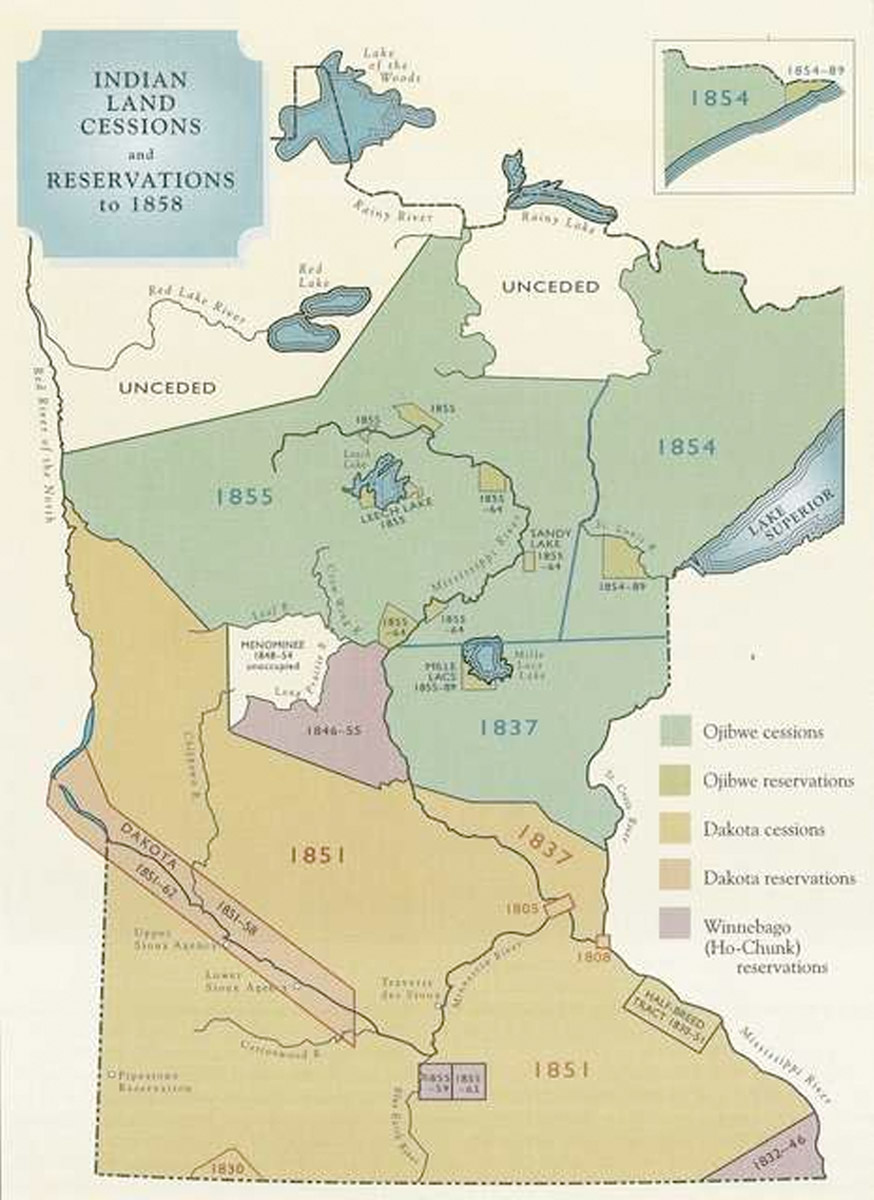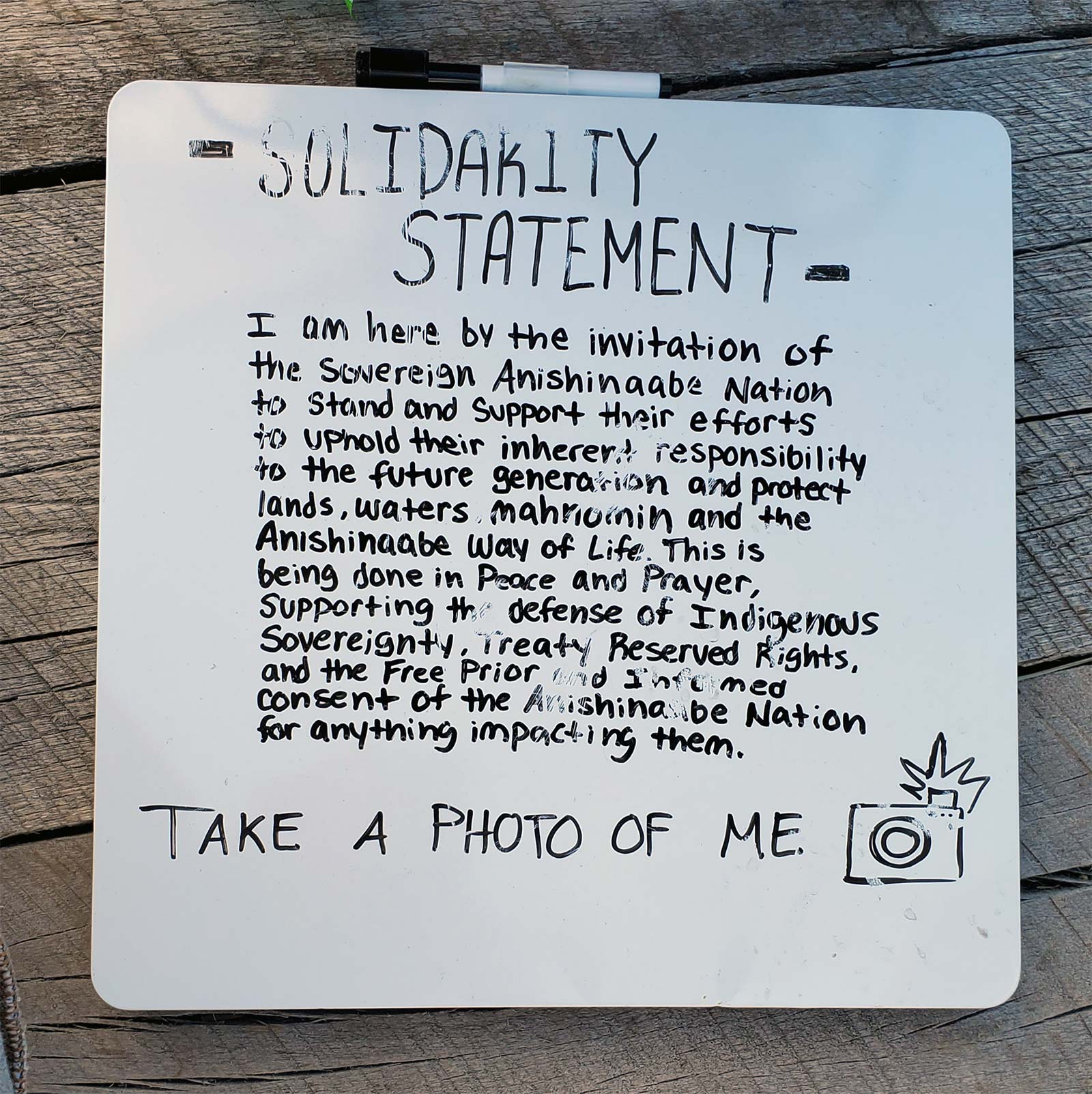On Monday, June 7 2021, over a thousand people followed Anishinaabe singers on hand drums into the valley near Mississippi’s headwaters. Enbridge Energy had laid an enormous timber mat boardwalk over the wetland to haul in heavy machinery for drilling the Line 3 tar sands oil pipeline beneath Mississippi River. At the invitation of local Anishinaabe leaders, hundreds of people proceeded onto the timber matting to pray with the river.
Photo Credit: Keri Pickett / Honor The Earth
Soon, round dance rhythms filled the air as people joined in ceremony and danced a round dance in the river itself.
The 1855 Treaty Encampment was situated over Mississippi River near its headwaters where Enbridge Energy was preparing to drill its 36″ Line 3 Tar Sands Oil Pipeline underneath the Riverscape.
The 1855 Treaty Encampment lay just outside the White Earth Reservation in northern Minnesota within the geographic boundaries of the 1855 Treaty of Washington signed between the Anishinaabe & the U.S. Government. Although the 1855 Treaty ceded a large swath of land to the U.S. Government, it implicitly reserves the right for Anishinaabe to hunt, fish, gather, travel, and practice ceremonies on lands they ceded. The Anishinaabe retain treaty-reserved usufructuary rights as a sovereign nation. These usufructuary rights were explicitly protected in the Treaty of 1837 and re-affirmed by the US Supreme Court in 1999.
Mississippi’s headwaters are a place of reverence for the Anishinaabe as explained by Jaime Arsenault, the White Earth Tribal Historic Preservation Officer and Vice Chair of the Repatriation Review Committee of the Smithsonian Natural History Museum:
“[B]y being towards the Headwaters of the Mississippi, Ojibwe people having ceremony there, there is this belief that it benefits everyone else downstream and that’s one of the tenants of Ojibwe society, [that] you’re always looking out and looking at how you can care for everyone around you.”
On Page Photo Credit: Map of Native American Land Cessions and Reservations to 1858. In “Territorial Imperative: How Minnesota Became the 32nd State,” by Rhoda Gilman (Making Minnesota Territory 1849-1858; Minnesota Historical Society Press, 1999). Src: Click to View
For eight days, the 1855 Treaty Encampment halted construction of the Line 3 pipeline in & around the river basin through prayerful occupation of the easement. A sacred fire was lit by Elders on June 8. Elder Leonard Thompson named the encampment Fire Light, embodying a message of defending treaty-reserved rights, clean water, and that a stable climate would shine across Turtle Island.
Each night, ceremony was held by the sacred fire. Each day, teachings were shared by Elders, locals, and storytellers from near and far – Anishinaabe, Dakota, Cheyenne, Yahooskin, Coast Salish, Apache, and more. The ceremony was a lawful exercise of treaty-reserved rights by the Anishinaabe people in the 1855 Treaty territory. Non-Native treaty partners were invited to uphold their treaty obligations by joining this sacred stand to protect Nibi (water). Meals were brought from local community members. People enjoyed clean Water. The boardwalk became a colorful neighborhood with each person finding ways to co-create community.
While the ceremonial gathering was underway, Enbridge could not proceed with their proposed drilling under Mississippi – construction in & around the river basin was put to a halt.
Background Photo Credit: Lucas Mullikan / @NowLiveFrom
The Solidarity Statement read by each individual and posted in various locations throughout the Fire Light Encampment:
“I am here by invitation of the Sovereign Anishinaabe Nation to stand and support their efforts to uphold their inherent responsibility to the future generations and protect Lands, Waters, Manoomin, and the Anishinaabe way of life. This is being done in peace and prayer, supporting the defense of Indigenous Sovereignty, treaty-reserved rights, and the free prior and informed consent of the Anishinaabe nation for anything impacting them.”
*Note: spelling and capitalization has been modified slightly between the image pictured at Fire Light Encampment and what is displayed as the Solidarity Statement on this website.
On June 13 2021, the Clearwater County Sheriff delivered a letter from Enbridge to the Fire Light Encampment and informed those participating in the ceremony that they need to leave. The group decided to remain on Mississippi River to await the final court decision in the Line 3 permitting process appealing the Certificate of Need permit, which was to be announced the following day.
On June 14, 2021 the Fire Light Encampment received word that the last major legal appeal of the Certificate of Need permit (which could halt Line 3 construction via the years-long pre-construction court battle) had been struck down by the Minnesota Court of Appeals in a 2-1, non-unanimous decision.
At this point, Fire Light Encampment was the only obstacle between Enbridge and Mississippi River. Determined to remain standing, ceremony participants did not leave. Camp supplies were carefully removed from harm’s way and the embers of the sacred fire were taken elsewhere to be kept alive, safe from harm. 51 water protectors were ultimately arrested on the waterway, issued a citation for misdemeanor trespass and released.
Criminal prosecution of the Fire Light Encampment ceremony attendees has played out in two separate courts based on whether the defendants are Native or non-Native.
For Native Defendants
Because the alleged “crime” took place within the geographic bounds of ceded treaty territory, the White Earth Tribal Court claimed jurisdiction over Fire Light Encampment participants who are Native, and most of those cases were transferred into tribal court.
On June 27th, 2022, the White Earth Band of Ojibwe Tribal Court dismissed the charges of the three remaining Anishinaabe defendants, affirming that Nancy Beaulieu (Leech Lake), Justin Keezer (White Earth) and Todd Thompson (White Earth) were legally exercising their treaty-reserved rights – under both the 1837 & 1855 treaties – as well as the authority granted under White Earth Tribal Code when they practiced eight days of ceremony on the headwaters of Mississippi River as part of the Fire Light Encampment.
For non-Native Defendants
Defendants of Fire Light Encampment who are not Native faced a misdemeanor charge of trespassing in Clearwater County Court.
Collectively, the group submitted hours of expert testimony from Ojibwe community leaders on the rights of Native people and worked alongside attorneys to add to the body of litigation that is pushing settler courts to honor treaties made more than a century ago.
The contested omnibus hearing for the non-Native defendants took place on July 28th, 2022 in Bagley, MN. Defendants’ briefs were filed on September 14th, 2022, the State’s brief was filed October 14th, 2022 and the defendants’ reply briefs were filed October 25th, 2022. The remaining non-Native defendants in the Fire Light Treaty Case were scheduled for jury trial May 8-12th, 2023 in Clearwater County District Court.
On April 25, 2023, all charges were dismissed. This dismissal came a day after the presiding judge affirmed that defendants would be allowed to “offer testimony that they were present as non-native treaty partners committed to honoring the treaty obligations of all signatories, in support and by invitation of the Anishinaabe Fire Light ceremonial encampment participants who hold off-reservation usufructuary rights.”
For a detailed timeline of the court proceedings, click here.
The Line 3 Tar Sands Oil Pipeline went into service on October 1st, 2021 despite almost a decade of resistance in the courts and on the ground. The trail of destruction Enbridge Energy has left behind is nothing short of catastrophic.
The harm caused by destruction of sacred land – without consent – can’t be quantified by facts and figures, nor can the grief & loss for future generations be encompassed by dollar amounts estimated for climate damages.
That said, a few of the most glaring facts are outlined below – most of which were only discovered due to the unrelenting work of citizen scientist groups such as Waadookawaad Amikwag, activists, and Water Protectors who continue to ground-truth & monitor the post-construction era of the Line 3 pipeline project.
>346 Million
Gallons of groundwater lost from various aquifers which were breached during construction.
67%
Of Enbridge’s Line 3 horizontal direct drilling attempts resulted in Frac-Outs
$287 Billion
Billion Dollars of Climate Damage according to Minnesota’s environmental impact statement
1000+
Quantity of initial arrests of native & non-natives who engaged in non-violent civil disobedience to stop construction of Line 3.
45
Currently known sites where groundwater began upwelling to the surface due to construction damages.
4
Line 3 workers arrested in sex trafficking stings in Minnesota while construction was underway. How is this connected?.
Interested in more info about the on-going environmental destruction caused by Enbridge’s Line 3 pipeline?
A group of volunteer citizen scientists as part of a group called “Wadookaawaad Amikwag” or “Those Who Help Beaver” has been ground-truthing post-construction damage and publishing ground-truthing videos accessible via their youtube channel.


